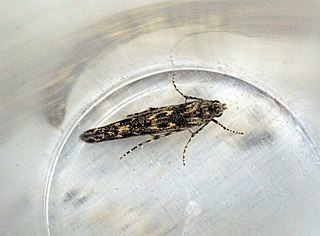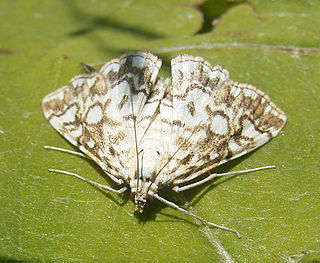
Edward Meyrick was an English schoolmaster and amateur entomologist. He was an expert on microlepidoptera and some consider him one of the founders of modern microlepidoptera systematics.

Batrachedra is the largest genus in the moth family Batrachedridae, with representatives all over the world. The early stages of most species are unknown. The genus name is derived from the Greek words batrachos, 'frog', and edra, 'seat', referring to the frog-like resting posture of the adult moths. As of 2018 at least some 114 species are known to belong to the genus.

Spilomelinae is a very species-rich subfamily of the lepidopteran family Crambidae, the crambid snout moths. With 4,135 described species in 344 genera worldwide, it is the most speciose group among pyraloids.

Urodidae, whose species are commonly known as false burnet moths, is a family of moths in the lepidopteran order. It is the type genus in the superfamily, Urodoidea, with three genera, one of which, Wockia, occurs in Europe.
Metachanda is the sole genus in tribe Metachandini of moth subfamily Oecophorinae. Metachandini was originally described as family Metachandidae by Edward Meyrick in 1911, and at the time also contained the genus Chanystis, which is currently unplaced to tribe within Oecophorinae. It has also previously been described as tribe Metachandini of subfamily Gelechiinae.

Scotorythra is a genus of moths in the family Geometridae erected by Arthur Gardiner Butler in 1883. All species of this genus are endemic to Hawaii.

Anacampsis is a worldwide genus of moth with most found in the nearctic and neotropical regions. It is in the family Gelechiidae. The larvae feed on a range of deciduous trees and shrubs in a rolled or folded leaf, or spun shoot.

Dichomeris is a genus of moths in the family Gelechiidae erected by Jacob Hübner in 1818.

Megacraspedus is a genus of moths in the family Gelechiidae, found primarily in the Palearctic.

Bradina is a genus of moths of the family Crambidae.

Udea is a genus of snout moths in the subfamily Spilomelinae of the family Crambidae. The genus was erected by Achille Guenée in 1845. The currently known 216 species are present on all continents except Antarctica. About 41 species are native to Hawaii.

Scoparia is a grass moth genus of subfamily Scopariinae. Some authors have assigned the synonymous taxon Sineudonia to the snout moth family (Pyralidae), where all grass moths were once also included, but this seems to be in error.

The Autostichinae are a subfamily of moths in the superfamily Gelechioidea. Like their relatives therein, their exact relationships are not yet very well resolved. The present lineage was often included in the concealer moth family (Oecophoridae), but alternatively it is united with the Symmocidae sensu stricto to form an expanded family Autostichidae.

Autosticha is a genus of gelechioid moths. It belongs to the subfamily Autostichinae, which is either placed in the concealer moth family (Oecophoridae), or in an expanded Autostichidae. It is the type genus of its subfamily. Originally, this genus was named Automola, but this name properly refers to a fly genus in family Richardiidae.
Hoplophanes is genus of moths of the family Heliozelidae. It was described by Edward Meyrick in 1897.

Acentropinae is a fairly small subfamily of the lepidopteran family Crambidae, the crambid snout moths. Species of this subfamily are exclusively found in wetlands and aquatic habitats.

Gracillariinae are a subfamily of moths which was described by Henry Tibbats Stainton in 1854.
Pessograptis thalamias is a moth in the family Gelechiidae. It was described by Edward Meyrick in 1923. It is found in Amazonas, Brazil.

Anacampsinae is a subfamily of moths in the family Gelechiidae.













